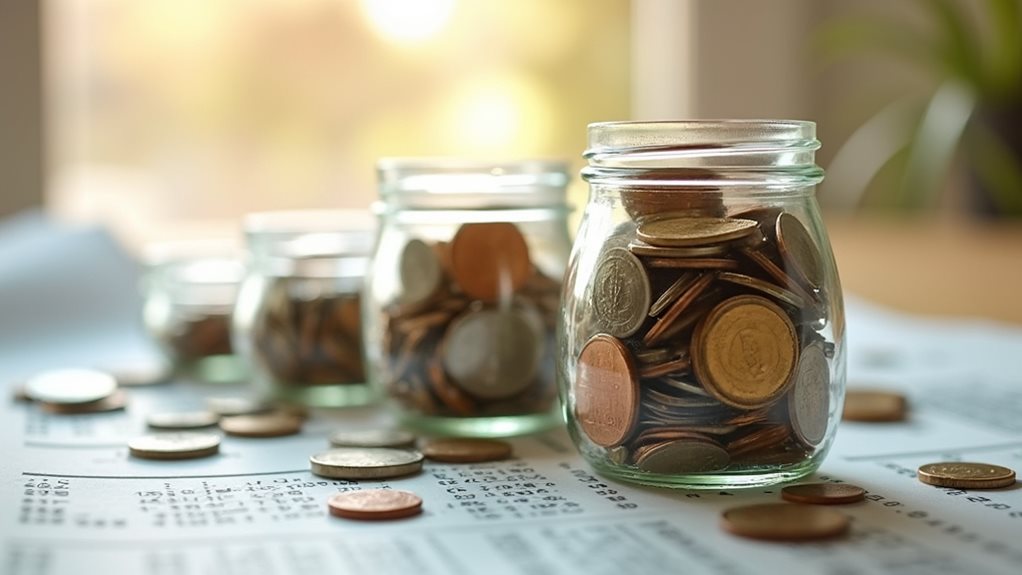APY determines how much money savings accounts earn annually through compound interest. Unlike basic interest rates, APY factors in compounding – where interest earns its own interest, like money making tiny money babies. Higher APY means better returns, especially with frequent compounding periods. Traditional banks offer measly rates around 0.41%, while online banks tend to sweeten the deal. Understanding the nitty-gritty of APY reveals the true potential of compound growth.

Money sitting idle in a low-yield account might as well be stuffed under a mattress. Understanding Annual Percentage Yield (APY) is essential for anyone who wants their money to actually work instead of just collecting dust. It's the real measure of what an investment earns over a year, and yes, it's different from that deceptively simple interest rate banks love to advertise.
Letting money languish in low-yield accounts is financial self-sabotage. Smart investors know APY is the true measure of their money's earning potential.
The magic of APY lies in compound interest – that beautiful phenomenon where interest earns interest on itself. Think of it as money making babies that then make their own babies. The more frequently this compounding happens, the better. Daily compounding beats monthly compounding, which beats annual compounding. It's just math, but it's math that matters. With the national average APY hovering around 0.41%, it's crucial to seek better options for your savings. A credit union's dividend rate functions similarly to interest rates but is specific to these member-owned institutions.
Banks and credit unions throw around terms like APY, APR, and interest rates like confetti at a parade. Here's the deal: APY tells you what you'll earn, APR tells you what you'll pay on loans, and basic interest rates are just the starting point.
Online banks, with their lower overhead costs, often flaunt higher APYs than traditional brick-and-mortar institutions. No fancy lobbies means more money in depositors' pockets.
The formula for calculating APY looks like something from a math teacher's nightmare: (1 + r/n)^n – 1. Thankfully, nobody actually calculates this by hand anymore. That's what calculators are for. The important thing is understanding that more frequent compounding periods equal more money. It's that simple.
Different accounts offer varying APYs. Regular savings accounts typically offer lower yields than Certificates of Deposit (CDs), but CDs lock up money like a financial prison sentence. Money market accounts often strike a balance between accessibility and earnings.
The highest APYs usually come with strings attached – minimum balances, withdrawal restrictions, or time commitments. For the best returns, savvy savers look for accounts with high APYs and frequent compounding periods.
Online banks often lead this pack, making traditional banks look downright stingy in comparison. Some people chase yields across different institutions like bargain hunters at a clearance sale. Smart move, actually.
Frequently Asked Questions
What's the Difference Between APY and APR?
APY and APR are totally different beasts.
APY shows what you earn on savings, including compound interest – basically interest on your interest. Sweet deal.
APR, on the other hand, reveals what you're paying on loans and credit cards, including fees but without compounding.
Here's the kicker: APY accounts for exponential growth while APR keeps it simple.
One makes you money, one costs you money. Pretty straightforward stuff.
Can APY Rates Change After Opening an Account?
Yes, APY rates can absolutely change after opening an account – and they do, frequently.
Banks adjust these rates whenever they want, no warning required. Market conditions, Federal Reserve decisions, and competitive pressures all play a role.
While traditional savings accounts tend to see modest shifts, high-yield accounts can experience more dramatic swings.
Only certain products like CDs lock in rates. Everything else? Fair game for changes.
Is a Higher APY Always Better for All Financial Products?
No, a higher APY isn't automatically better for every financial product.
Sure, bigger numbers look nice, but there's usually a catch. High APY accounts often come with strict minimum balance requirements, limited access to funds, or hefty penalties for early withdrawals.
Some products, like CDs, lock up money for months or years. Fees can eat into those attractive rates too.
And in low-interest environments, even "high" APYs might barely keep pace with inflation.
How Often Do Banks Typically Compound Interest for Savings Accounts?
Banks typically compound interest daily for savings accounts – it's industry standard these days.
Monthly compounding still exists but it's less common. Daily compounding means interest is calculated and added to the balance every single day, letting that money start earning its own interest immediately.
Pretty neat system. While some specialty accounts might compound differently, the big banks have largely settled on daily compounding for basic savings accounts.
Are APY Earnings Subject to Federal and State Taxes?
Yes, those APY earnings aren't sneaking past Uncle Sam.
Interest earned from savings accounts gets taxed at both federal and state levels – it's just like regular income. Banks send out 1099-INT forms for interest over $10, and that money needs to show up on tax returns.
The higher someone's income bracket, the more they'll pay.
Though there's one interesting twist – some investments, like municipal bonds, can actually dodge the tax bullet entirely.









